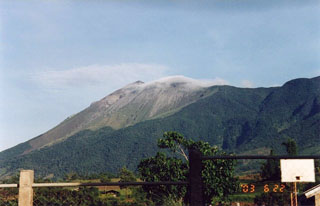Report on Kanlaon (Philippines) — 2 April-8 April 2025
Smithsonian Institution / US Geological Survey
Weekly Volcanic Activity Report, 2 April-8 April 2025
Managing Editor: Sally Sennert.
Please cite this report as:
Global Volcanism Program, 2025. Report on Kanlaon (Philippines) (Sennert, S, ed.). Weekly Volcanic Activity Report, 2 April-8 April 2025. Smithsonian Institution and US Geological Survey.
Kanlaon
Philippines
10.4096°N, 123.13°E; summit elev. 2422 m
All times are local (unless otherwise noted)
The Philippine Institute of Volcanology and Seismology (PHIVOLCS) reported continuing eruptive activity at Kanlaon during 1-7 April and a notable explosion on 8 April. The seismic network recorded 2-23 daily volcanic earthquakes, including 2-9 daily (except for 6 April) periods of volcanic tremor lasting two minutes to two hours and five minutes. Average daily sulfur dioxide emissions ranged from 1,283 to 2,725 tonnes per day. Moderate-to-voluminous gas-and-steam emissions that occasionally contained ash rose 100-600 m crater rim and drifted W, WSW, and SW. There were 2-9 periods of ash emissions during 1-5 April that each lasted 3 minutes to two minutes to two hours and five minutes.
A moderately-explosive eruption occurred at 0551 on 8 April and lasted for 56 minutes based on seismic data and visual observations. A voluminous gray ash plume slowly rose 4 km above the crater rim and drifted W and SW. Rumbling was heard and pyroclastic density currents traveled 1 km down the S flank. Large ballistic fragments were ejected a few hundred meters and set vegetation on fire on the upper E flank, near the summit. Minor ashfall was reported in the barangays including Roberto Salas Benedicto, La Granja, Haguimit, Nagasi, Yubo, Ara-al, San Miguel, and Cubay (La Carlota City), Mailum, Ilijan, and Binubuhan (Bago City), and Sag-ang and Mansalanao (La Castellana). Sulfur odors were notable in Cubay and less notable in areas as far as the Municipality of Hinigaran. According to a news article ashfall was widespread and recorded as far as 195 km W. About six domestic flights and one bound for Singapore were canceled. The Office of Civil Defense government offices, except those involved in disaster and emergency response, closed in La Carlota City along with face-to-face classes at all levels. Private establishments were encouraged to suspend work. Heavy ashfall in Ara-al within an hour of the eruption caused poor road visibility, and the river at the Najalin Bridge between Cubay and La Granja was contaminated with ashfall and there was poor visibly along the road in that area as well. Many of the residents that had evacuated within a 6-km radius due to increased eruptive activity in December 2024 remained in evacuation centers or elsewhere; the Disaster Response Operations Monitoring and Information Center (DROMIC) reported that as of 1800 on 19 April there were 8,315 people (2,607 families) spread across 22 evacuation centers and another 11,892 people (3,702 families) staying elsewhere. The Alert Level remained at 3 (on a scale of 0-5); the public was warned to stay 6 km away from the summit and pilots were warned not to fly close to the volcano.
Geological Summary. Kanlaon volcano (also spelled Canlaon) forms the highest point on the Philippine island of Negros. The massive andesitic stratovolcano is covered with fissure-controlled pyroclastic cones and craters, many of which are filled by lakes. The largest debris avalanche known in the Philippines traveled 33 km SW from Kanlaon. The summit contains a 2-km-wide, elongated northern caldera with a crater lake and a smaller but higher active vent, Lugud crater, to the south. Eruptions recorded since 1866 have typically consisted of phreatic explosions of small-to-moderate size that produce minor local ashfall.
Sources: Philippine Institute of Volcanology and Seismology (PHIVOLCS), Office of Civil Defense, Disaster Response Operations Monitoring and Information Center (DROMIC), CBS News

